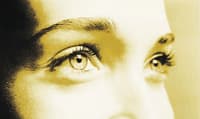Allergan Education Forum
Treating Dry Eye's Multiple
Guises
Two case histories offer lessons on relieving
a complex and life-disturbing problem.
BY LISA BATTAT, M.D., FRANK BUCCI, M.D., AND MARK A. TERRY, M.D.

LISA BATTAT, M.D. |

FRANK BUCCI, M.D. |

MARK A. TERRY, M.D. |
Dry eye is a widespread disorder that diminishes an individual's quality of life. Those suffering from ocular surface disease tend to be less productive on the job, lacking interest in leisure activities and given to all manner of frustration. Dry eye can trigger depression, draining a person's self-esteem. One survey found that more than a third of dry eye sufferers claimed to be "less confident" owing to their disease. Dry eye can disrupt a person's driving ability and make an ordeal of everyday visual tasks normally taken for granted.
From the patient's perspective, then, even moderate dry eye clearly is a major life-impacting problem. Clinicians need to view it in this context. We see many pa-tients who have been treated for other eye problems, but can't seem to get the help they need to alleviate their dry eye symptoms.
Fortunately, we have new ways to deliver relief. In these two real-life cases, we examine the complexities of dry eye and how to treat it.
Kristen: 37, Fluctuating vision and foreign body sensation, asking about LASIK
History and diagnostic data. Kristen is a 5.00D myope complaining of foreign body sensation. She has worn soft contact lenses for 22 years and has had difficulty for the past 2 years due to fluctuating vision. She has systemic allergies and intermittent allergic conjunctivitis. She sometimes takes antihistamines. In addition, Kristen has some anxiety for which she takes fluoxetine (Prozac) intermittently.
Kristen came to the office asking about LASIK. She didn't want to wear eyeglasses and was upset about the prospect of wearing bifocals. LASIK was a possibility, but we needed to rehabilitate her first.

Treatment. Clearly, Kristen needed to switch from preserved to nonpreserved tears. She was advised to wear her eyeglasses instead of contact lenses and started on cyclosporine ophthalmic emulsion 0.05% (Restasis).
In this case, we used collagen punctal plugs to boost the amount of tears on the ocular surface. Silicone plugs are a possible future option. Kristen started taking omega-3 fatty acids to increase the quality of the oils on the ocular surface. She also needs to taper her use of antihistamines and -- if her prescribing doctor assents -- the fluoxetine as well. She can use a nonpreserved ointment at bedtime if her eyes are very dry and scratchy.
Outcome. We saw Kristen again at 1 week and 1 month. Her foreign body sensation progressively de-creased, as did her SPK. Her vision is stabilizing -- no more wide fluctuations during the day. Her collagen plugs dissolved within about 1 or 2 weeks, and the cyclosporine started restoring the tear production, resolving her symptoms in 4 to 8 weeks.
It's not yet time for Kristen to get LASIK, but we'll monitor her over the next 6 months as she continues on cyclosporine.
Dorothea: 78, Trouble reading, meibomitis and blepharitis
History and diagnostic data. Dorothea was diagnosed with dry eye more than 10 years ago. She now has trouble reading more than 20 minutes. She has tried every artificial tear and now uses them 6 to 8 times a day, plus ointment at night. Her eyes still itch and burn.
Dorothea, who is pseudophakic, had unaided vision of 20/30. She had meibomitis and probably some blepharitis. Her TBUT was about 4 seconds, and her Schirmer test came to 6 mm. She had some mild central and heavy inferior SPK, as well as some staining of the inferior cornea. Dorothea also has rosacea.
Treatment. Because Dorothea has been frustrated with dry eye for 10 years, we wanted to get her some early rewards. She was started on a light topical steroid four times a day for 7 to 10 days. She also started cyclosporine twice a day. Also part of her regimen was the use of hot packs for at least 10 minutes a day, lid scrubs and continued use of nonpreserved artificial tears.
Outcome. After 2 weeks, Dorothea finally found relief with less irritation and burning than she'd experienced in 10 years. At 2 months, her vision had improved to 20/20, her TBUT had increased to 12 seconds, and she was using artificial tears only two to four times a day. She finished the steroids. Continued use of hot packs improved her meibomian inflammation, her lid hygiene was assiduous and helpful, and the cyclosporine was improving her tear film.
After 4 months on cyclosporine, Dorothea had no burning or foreign body sensation. Her eyes, she said, felt "comfortable." Her inferior SPK was gone, her meibomitis was largely resolved and her TBUT was now 14 seconds. She's using hot packs now just every other day.
At 6 months, Dorothea no longer uses artificial tears. Her Schirmer test is 10 mm. She'd rather stop using her hot packs, but we tell her that because of her rosacea, she'll always need to use them every other day. But that's a minor hassle. Overall, she's feeling great.
Dr. Battat is the director of cornea, external disease and refractive surgery at Everrett & Hurite Ophthalmic Associates in Pittsburgh. Dr. Bucci, an internationally recognized cataract and refractive surgery specialist, is medical director of the Bucci Laser Vision Institute and Ambulatory Surgical Center in Wilkes-Barre, Pa. Dr. Terry is director of Corneal Services at the Devers Eye Institute and scientific director of the Oregon Lions Vision Research Laboratory in Portland, Ore.
SPONSORED BY









